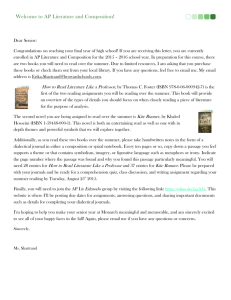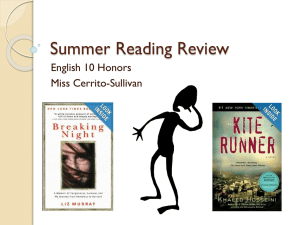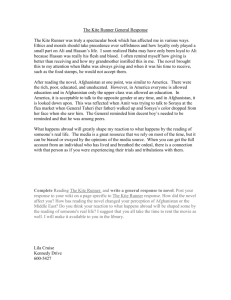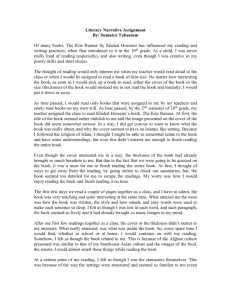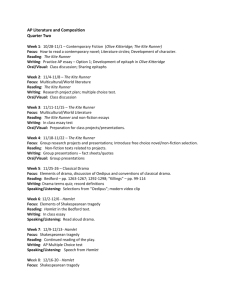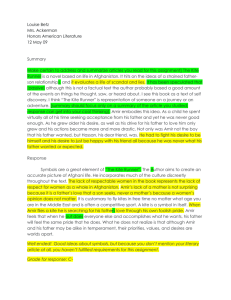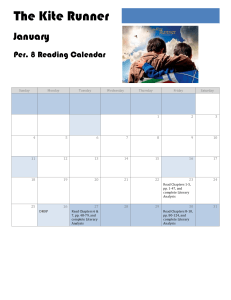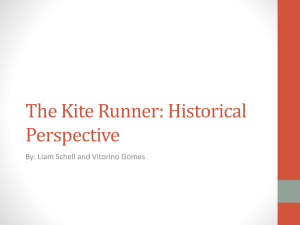The Kite Runner - Providence School Department
advertisement
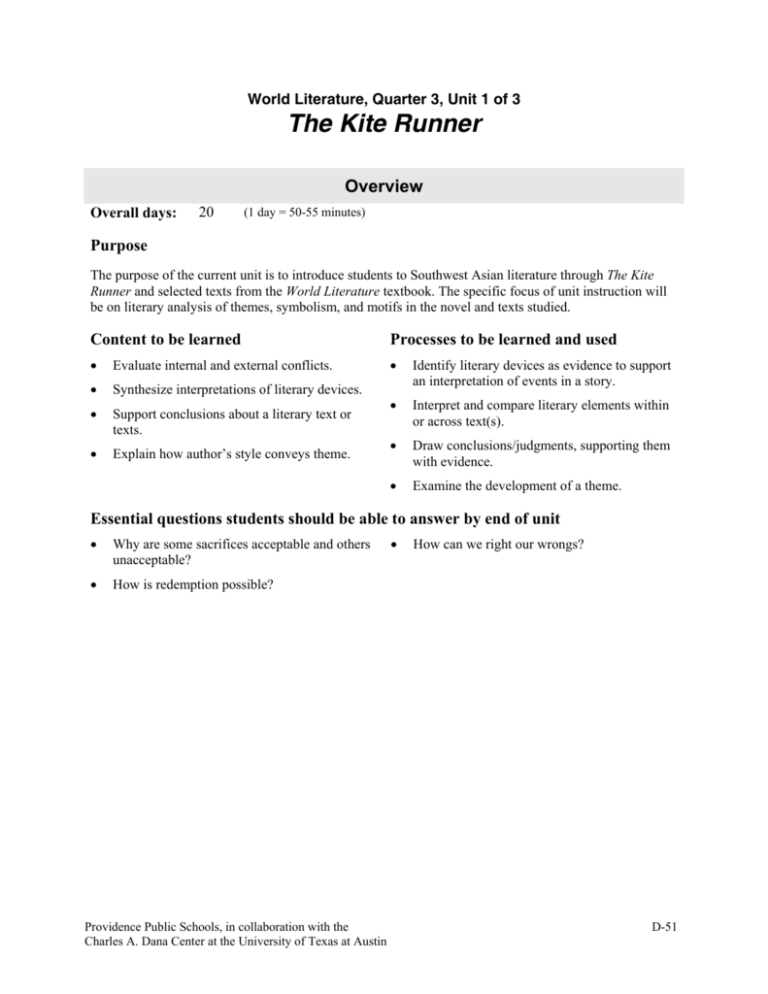
World Literature, Quarter 3, Unit 1 of 3 The Kite Runner Overview Overall days: 20 (1 day = 50-55 minutes) Purpose The purpose of the current unit is to introduce students to Southwest Asian literature through The Kite Runner and selected texts from the World Literature textbook. The specific focus of unit instruction will be on literary analysis of themes, symbolism, and motifs in the novel and texts studied. Content to be learned Processes to be learned and used Evaluate internal and external conflicts. Synthesize interpretations of literary devices. Identify literary devices as evidence to support an interpretation of events in a story. Support conclusions about a literary text or texts. Interpret and compare literary elements within or across text(s). Explain how author’s style conveys theme. Draw conclusions/judgments, supporting them with evidence. Examine the development of a theme. Essential questions students should be able to answer by end of unit Why are some sacrifices acceptable and others unacceptable? How is redemption possible? Providence Public Schools, in collaboration with the Charles A. Dana Center at the University of Texas at Austin How can we right our wrongs? D-51 World Literature, Quarter 3, Unit 1 Version 2 The Kite Runner (20 days) Written Curriculum Common Core State Standards for English Language Arts Reading Reading Standards for Literature Key Ideas and Details RL.9-10.2 Determine a theme or central idea of a text and analyze in detail its development over the course of the text, including how it emerges and is shaped and refined by specific details; provide an objective summary of the text. RL.9-10.3 Analyze how complex characters (e.g., those with multiple or conflicting motivations) develop over the course of a text, interact with other characters, and advance the plot or develop the theme. Integration of Knowledge and Ideas RL.9-10.7 Analyze the representation of a subject or a key scene in two different artistic mediums, including what is emphasized or absent in each treatment (e.g., Auden’s “Musée des Beaux Arts” and Breughel’s Landscape with the Fall of Icarus). RL.9-10.9 Analyze how an author draws on and transforms source material in a specific work (e.g., how Shakespeare treats a theme or topic from Ovid or the Bible or how a later author draws on a play by Shakespeare). Reading Standards for Informational Text Key Ideas and Details RI.9-10.2 Determine a central idea of a text and analyze its development over the course of the text, including how it emerges and is shaped and refined by specific details; provide an objective summary of the text. Integration of Knowledge and Ideas RI.9-10.7 Analyze various accounts of a subject told in different mediums (e.g., a person’s life story in both print and multimedia), determining which details are emphasized in each account. Writing Text Types and Purposes W.9-10.1 Write arguments to support claims in an analysis of substantive topics or texts, using valid reasoning and relevant and sufficient evidence. a. D-52 Introduce precise claim(s), distinguish the claim(s) from alternate or opposing claims, and create an organization that establishes clear relationships among claim(s), counterclaims, reasons, and evidence. Providence Public Schools, in collaboration with the Charles A. Dana Center at the University of Texas at Austin The Kite Runner (20 days) World Literature, Quarter 3, Unit 1 Version 2 b. Develop claim(s) and counterclaims fairly, supplying evidence for each while pointing out the strengths and limitations of both in a manner that anticipates the audience’s knowledge level and concerns. c. Use words, phrases, and clauses to link the major sections of the text, create cohesion, and clarify the relationships between claim(s) and reasons, between reasons and evidence, and between claim(s) and counterclaims. d. Establish and maintain a formal style and objective tone while attending to the norms and conventions of the discipline in which they are writing. e. Provide a concluding statement or section that follows from and supports the argument presented. Production and Distribution of Writing W.9-10.4 Produce clear and coherent writing in which the development, organization, and style are appropriate to task, purpose, and audience. (Grade-specific expectations for writing types are defined in standards 1–3 above.) Research to Build and Present Knowledge W.9-10.9 Draw evidence from literary or informational texts to support analysis, reflection, and research. a. Apply grades 9–10 Reading standards to literature (e.g., “Analyze how an author draws on and transforms source material in a specific work [e.g., how Shakespeare treats a theme or topic from Ovid or the Bible or how a later author draws on a play by Shakespeare]”). b. Apply grades 9–10 Reading standards to literary nonfiction (e.g., “Delineate and evaluate the argument and specific claims in a text, assessing whether the reasoning is valid and the evidence is relevant and sufficient; identify false statements and fallacious reasoning”). Range of Writing W.9-10.10 Write routinely over extended time frames (time for research, reflection, and revision) and shorter time frames (a single sitting or a day or two) for a range of tasks, purposes, and audiences. Speaking and Listening Comprehension and Collaboration SL.9-10.1 Initiate and participate effectively in a range of collaborative discussions (one-on-one, in groups, and teacher-led) with diverse partners on grades 9–10 topics, texts, and issues, building on others’ ideas and expressing their own clearly and persuasively. a. Come to discussions prepared, having read and researched material under study; explicitly draw on that preparation by referring to evidence from texts and other research on the topic or issue to stimulate a thoughtful, well-reasoned exchange of ideas. b. Work with peers to set rules for collegial discussions and decision-making (e.g., informal consensus, taking votes on key issues, presentation of alternate views), clear goals and deadlines, and individual roles as needed. Providence Public Schools, in collaboration with the Charles A. Dana Center at the University of Texas at Austin D-53 World Literature, Quarter 3, Unit 1 Version 2 The Kite Runner (20 days) c. Propel conversations by posing and responding to questions that relate the current discussion to broader themes or larger ideas; actively incorporate others into the discussion; and clarify, verify, or challenge ideas and conclusions. d. Respond thoughtfully to diverse perspectives, summarize points of agreement and disagreement, and, when warranted, qualify or justify their own views and understanding and make new connections in light of the evidence and reasoning presented. Language Vocabulary Acquisition and Use L.9-10.4 Determine or clarify the meaning of unknown and multiple-meaning words and phrases based on grades 9–10 reading and content, choosing flexibly from a range of strategies. L.9-10.5 a. Use context (e.g., the overall meaning of a sentence, paragraph, or text; a word’s position or function in a sentence) as a clue to the meaning of a word or phrase. b. Identify and correctly use patterns of word changes that indicate different meanings or parts of speech (e.g., analyze, analysis, analytical; advocate, advocacy). c. Consult general and specialized reference materials (e.g., dictionaries, glossaries, thesauruses), both print and digital, to find the pronunciation of a word or determine or clarify its precise meaning, its part of speech, or its etymology. d. Verify the preliminary determination of the meaning of a word or phrase (e.g., by checking the inferred meaning in context or in a dictionary). Demonstrate understanding of figurative language, word relationships, and nuances in word meanings. L.9-10.6 a. Interpret figures of speech (e.g., euphemism, oxymoron) in context and analyze their role in the text. b. Analyze nuances in the meaning of words with similar denotations. Acquire and use accurately general academic and domain-specific words and phrases, sufficient for reading, writing, speaking, and listening at the college and career readiness level; demonstrate independence in gathering vocabulary knowledge when considering a word or phrase important to comprehension or expression. Language Progressive Skills Language skills and understanding below have been marked with an asterisk in CCSS as they are likely to require continued attention in higher grades as they are applied to increasingly sophisticated writing and speaking. Please reference the Language Progressive Chart by grade (CCSS, page 56 and Appendix A) at www.corestandards.org for additional information. Knowledge of Language L.6.3 D-54 Use knowledge of language and its conventions when writing, speaking, reading, or listening. a. Vary sentence patterns for meaning, reader/listener interest, and style.* b. Maintain consistency in style and tone.* Providence Public Schools, in collaboration with the Charles A. Dana Center at the University of Texas at Austin The Kite Runner (20 days) World Literature, Quarter 3, Unit 1 Version 2 Notes, Clarifications, and Prerequisites In the previous unit, students have completed a study of African literature focusing on Things Fall Apart and selections from the novel. The focus of the unit was on analysis of character, conflict, theme, and cultural/historical perspective. The purpose of the current unit is to introduce students to Southwest Asian literature through The Kite Runner and selected texts from the World Literature textbook. The specific focus of unit instruction will be on literary analysis of themes, symbolism, and motifs in the novel and texts studied. This will prepare students for the next unit, in which they will write a research report on a human rights issue in a specific country and give a multimedia presentation to the United Nations persuading it to act on the human rights issue. In this unit, students will most likely struggle with keeping up with the reading and completing the ondemand writing in the time required. Students will also struggle to complete the unit summative assessment/research paper in the time allotted. In order to support students in meeting the objectives within the given time frame, introduce, at the end of this unit, the research paper prompt so that students can generate ideas to develop further in the next unit. Taught Curriculum Learning Objectives Resources Students will be able to: World Literature, Glencoe McGraw-Hill, Teacher Edition, 2009 Evaluate characters’ actions and interactions with regard to internal and external conflicts. Synthesize interpretations of literary devices from multiple literary selections. Draw conclusions based on quotations and annotations from both short and lengthy literary selections. Part One: Southwest Asia (pp. 436-443) The Parable of the Prodigal Son from The New Testament (pp. 486-490) from The Qur’an (pp. 491-495) “The Letter from Persepolis: The Story of a Childhood” (pp. 532-541) Use interpretations of literary devices to support conclusions about a literary text or texts. Unit 3 Teacher Resources: Writing, Speaking, Reading, Listening, Glencoe McGraw-Hill, Teacher Edition, 2009 (pp. 316-325) Explain how author’s style—including literary devices, such as symbolism—conveys theme. Writing Constructed Responses, Glencoe McGrawHill, Teacher Edition, 2009 Analyze representations of the Prodigal Son in art and literature Section 2: Writing a Literary Analysis (pp. 3641) Rubric for Short Constructed Responses The Kite Runner, by Khaled Hosseini, Riverhead, 2003 Providence Public Schools, in collaboration with the Charles A. Dana Center at the University of Texas at Austin D-55 World Literature, Quarter 3, Unit 1 Version 2 The Kite Runner (20 days) The Kite Runner Companion Curriculum, Amnesty International USA Human Rights Education Program (pp. 37-48), www.amnestyusa.org/ education/pdf/kiterunnerhigh.pdf Materials Sticky notes Instructional Considerations Key Vocabulary atone Pashtuns Tajiks conflict in change sacrifice Uzbek and Turkmen Hazaras social forces social standing wisdom literature Vocabulary from The Kite Runner unatoned (p. 1) façade (p. 97) unrequited (p. 219) harelipped (p. 2) sluiced (p. 108) etched (p. 227) atrophied (p. 8) silhouettes (p. 119) animosity (p. 228) veracity/veracious (p. 12) encapsulated (p. 123) ruminate (p. 231) nemesis (p. 29) reputable (p. 148) emaciated (p. 231) coup d’etat (p. 36) reticence (p. 157) contemptuous (p. 236) trepidation (p. 41) chastise (p. 165) ramshackle (p. 246) integrity (p. 54) humility (p. 168) unadulterated (p. 247) morose (p. 61) reverberate (p. 174) absurdity (p. 251) resignation (p. 76) ambivalent (p. 186) benevolence (p. 248) guileless (p. 78) bemoaned (p. 188) cataracts (p. 249) insomniac (p. 86) Planning and Instructional Delivery Considerations The purpose of the current unit is to introduce students to Southwest Asian literature through reading The Kite Runner by Khalid Hosseini and selected texts from the World Literature textbook. BEGINNING of the unit (2 days) Introduce the Unit: Discuss the Essential Questions and Learning Objectives. Review the unit’s key vocabulary to build background knowledge. As a foundation for understanding The Kite Runner, students should read the Overview of Unit 3 and the selections from The Qur’an from the World Literature anthology, using the strategies included in the Before You Read section. As students read, help them focus on the Big Idea, Literary Element, and Reading Strategy questions. Use graphic organizers (Unit 3 Teacher Resources: Writing, Speaking, D-56 Providence Public Schools, in collaboration with the Charles A. Dana Center at the University of Texas at Austin The Kite Runner (20 days) World Literature, Quarter 3, Unit 1 Version 2 Reading, Listening, pp. 316-325) with these stories for building scaffolding for the summative assessment. Use the resources at the Kite Runner Companion Curriculum site listed in the Resources section to introduce students to Afghanistan culture and politics, especially as they relate to the Taliban and its control of women and children. MIDDLE of the unit (16 days) Class discussions should focus on answering the Essential Questions. Assign students to read The Kite Runner in sections. Students should respond to the text using the reader response stems below. Responding to the stems on sticky notes in the margins helps students remain focused on the information on the page as it relates to the stem on the sticky note. As students read, they should pay special attention to the relationship between cause and effect in the plot, character actions in relation to internal and external conflicts, and literary elements such as motif, theme, setting, and characterization. Possible chapter assignments are listed below. Possible reader response stems for the marginal sticky notes include: I think . . . I wonder if . . . I am confused by . . . This reminds me of . . . I predict . . . Listed below are prompts for chapters or groups of chapters. Students should be assigned a reader response journal that incorporates both the stems above and the prompts below to help them in understanding the novel. Assign the following prompts or the Essential Questions. Chapters 1 and 2: At the end of Chapter 1, the narrator says “…and made me what I am today.” Think of the experiences you’ve had that have shaped you into who you are today. Write about one of them. Chapters 3 and 4: What makes someone a friend? Chapters 5 and 6: On page 22, Baba says “A boy who won’t stand up for himself becomes a man who can’t stand up to anything.” Do you agree or disagree? Explain and connect to the reading. Chapter 7: What is a coward? Chapter 8: Loyalty, truth, sacrifice, and punishment: What does each word mean and how do these words relate to one another? Chapters 9 and 10: Does anyone deserve to be forgiven? Chapter 11: How do people hide or escape from their problems and why? Chapter 12: What is it about love that heals wounds? Chapter 13: In Hindu and Buddhist philosophy, the concept of karma means the belief that the quality of your current and future life is determined by your behavior in this and previous lives. It also means destiny and fate. Do you believe in karma? Chapters 15 and 16: Can a wrong really be made right? Providence Public Schools, in collaboration with the Charles A. Dana Center at the University of Texas at Austin D-57 World Literature, Quarter 3, Unit 1 Version 2 The Kite Runner (20 days) Chapters 17 and 18: Under what circumstances would you lie to someone you love? Chapter 19: Why is going home sometimes the hardest thing to do? Chapter 20: Do you think it is acceptable to sacrifice one’s life for the good of many lives? Explain. Chapter 21: Is Farid right when he says, “Just forget it all. Makes it easier . . . to go on.” (p. 263) Explain. Chapter 22: What lessons do children really need to learn to grow up well? Chapter 23: Why are father and son relationships so important? Chapter 24: Should you ever make a promise you can’t keep? Explain. Chapter 25: “If someone were to ask me today whether the story of Hassan Sohrab and me ends with happiness, I wouldn’t know what to say” (p. 357). What do you say? How do you think the story should end? Read “The Letter from Persepolis: The Story of a Childhood” to make comparisons between the way Marji accepts their maid Mahri and the way Amir treats and accepts Hassan. A comparison can also be made between how their respective societies treat people of different social classes. Read “The Parable of the Prodigal Son” in the World Literature textbook around when students are reading Chapter 16 of The Kite Runner. Use the “View the Art” prompt on page 489 to discuss representations of the story in the art and in The Kite Runner (in Chapter 16 of The Kite Runner, Hassan’s mother returns and is forgiven by Hassan). END of the unit (2 days) Toward the end of the reading of the novel, begin having discussions with students about the human rights issues in the novel, specifically those related to the Taliban (around chapter 20). Use the tools on the following pages when preparing students for the summative assessment: Writing Constructed Responses Section 2: Writing a Literary Analysis (pp. 36-41). In preparation for the summative assessment, have students answer these two questions using the above resource: Why does a person have a need for atonement? How does the sacrificial lamb symbol show itself in The Kite Runner? Assessed Curriculum Formative Assessments Journal entries kept during this unit also serve as the formative assessments. The journal entries contain answers to reader response stems and prompts such as the ones found in the Planning and Instructional Delivery Considerations section of this unit. The journal entries can be assessed using the Rubric for Short Constructed Responses in the Glencoe Writing Constructed Responses teacher resource. D-58 Providence Public Schools, in collaboration with the Charles A. Dana Center at the University of Texas at Austin The Kite Runner (20 days) World Literature, Quarter 3, Unit 1 Version 2 Summative Assessment Students will write a literary analysis/argumentative essay that makes an interpretive claim in the form of a thesis on an identified theme from The Kite Runner. Students should select one of the following topics for their essay: The desire for atonement is an important theme in the novel. How does Amir atone for his sins, or does he? Why is it so important that he try? Can his desire to atone be compared with Baba’s? OR The sacrificial lamb is a recurring symbol (motif) in the novel. Why is this image important in the context of the novel? What does it show? What characters and situations does it apply to? Use the following Common Core State Standards for argument writing as the basis for criteria and rubric: W.9-10.1 Write arguments to support claims in an analysis of substantive topics or texts, using valid reasoning and relevant and sufficient evidence. a. Introduce precise claim(s), distinguish the claim(s) from alternate or opposing claims, and create an organization that establishes clear relationships among claim(s), counterclaims, reasons, and evidence. b. Develop claim(s) and counterclaims fairly, supplying evidence for each while pointing out the strengths and limitations of both in a manner that anticipates the audience’s knowledge level and concerns. c. Use words, phrases, and clauses to link the major sections of the text, create cohesion, and clarify the relationships between claim(s) and reasons, between reasons and evidence, and between claim(s) and counterclaims. d. Establish and maintain a formal style and objective tone while attending to the norms and conventions of the discipline in which they are writing. e. Provide a concluding statement or section that follows from and supports the argument presented. Providence Public Schools, in collaboration with the Charles A. Dana Center at the University of Texas at Austin D-59 World Literature, Quarter 3, Unit 1 Version 2 The Kite Runner (20 days) Notes D-60 Providence Public Schools, in collaboration with the Charles A. Dana Center at the University of Texas at Austin
